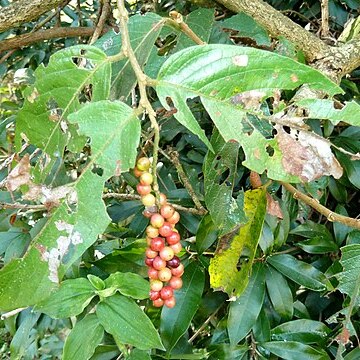Perennial tree or shrub, 0.55-8.00 m high; branches drooping; crown dense; twigs lenticellate; young shoots and buds sparingly to densely fulvous-or ferruginous-tomentose, or pubescent. Leaves stratified, elliptic-obovate to oblong-oblanceolate, base rounded or cuneate, apex rounded or obtuse, thickly chartaceous to thinly coriaceous; petioles adaxially canaliculate. Stipules lanceolate to linear-lanceolate, acute, evenly to densely pubescent or tomentose. Male inflorescences terminal or subterminal on short lateral shoots; bracts minute. Male flowers: calyx 3-5-lobed, unequal, subacute or obtuse, pubescent, ciliate. Female inflorescences lateral, densely paniculate. Female flowers: calyx cupular, 3-or 4-lobed; ovary compressed-ellipsoid, smooth, glabrous; styles terminal, bifid, strongly recurved, glabrous. Flowering time Dec. Seeds ellipsoid.
A shrub or small tree. It can grow to 15 m tall. The crown can be round and spreading or drooping. The bark is pale and flaky. The young twigs are covered with red hairs. The leaves are simple, large and without teeth. They can be 2.5-15 cm long and 1.9-10 cm wide. The leaf shape and hairiness varies. There are about 7 pairs of conspicuous veins. The flowers are small and greenish. Male and female flowers occur on separate trees. The fruit is small and with one seed. It is 7 mm long by 5 mm wide. Several occur in a bunch. The fruit are oval and flattened. The colour varies between yellow, pink, red and black and fruit of several colours can occur on one bunch. The fruit are edible.
Leaf blades 2–12(20) × 1–6(7) cm, elliptic-obovate to oblong-oblanceolate, rounded or obtuse at the apex, less often shortly acuminate, rounded or cuneate, rarely shallowly cordulate at the base, thickly chartaceous to thinly coriaceous, pubescent along the midrib but otherwise glabrous or almost so on upper surface, sparingly pubescent to densely fulvous-or ferrugineous-tomentose beneath, dark green and glossy above, paler and duller beneath; lateral nerves in 4–8(9) pairs, the lower camptodromous, the upper brochidodromous, somewhat impressed above, prominent beneath, reticulation lax.
Male flowers: calyx (3)4(5)-lobed, the lobes 0.5–1 mm long, unequal, subacute or obtuse, pubescent without, ciliate, yellowish-green; disk variable, continuous or fragmented, thick, partially or completely surrounding the (3)4(5) stamens; filaments 2.5 mm long, white, anthers 0.5 mm long, often reddish; pistillode minute, usually slender, sparingly pubescent.
Female flowers: pedicels 0.5–1 mm long, extending to 2 mm in fruit; calyx 1 mm long, cupular, shallowly 3–4-lobed, otherwise ± as in the male; disk c. 1 mm in diameter, shallowly cupular, crenellate, ovary 1 × 0.75 mm, compressed-ellipsoid, smooth, glabrous; styles 2–4, ± terminal, 0.75 mm long, bifid, strongly recurved, glabrous, whitish.
Fruits 5–7(8) × 4–5(6) mm when dried, 6–8(9) × 5–6(7) mm when fresh, ellipsoid-suborbicular, slightly asymmetrical, strongly laterally compressed, irregularly and coarsely reticulate-rugulose when dried, green at first, later becoming whitish, red, purple or black when ripe.
A spreading, sometimes scrambling, deciduous shrub or small tree commonly up to 8 m tall, branched from the base or with a clear bole to up to 4.5 m; branches drooping; crown often dense; bark smooth, furrowed or scaly, light yellowish-brown to dark grey.
Dioecious shrub or tree, up to 10 m high. Leaves bright, glossy green above, paler green below. Fruits 8 x 4 mm, white when young, becoming bright red and finally black in dense tassel-like sprays, 80-120 mm long. Flowers dull yellow.
Female inflorescences 1.5–9(12) cm long, compound-spicate with 1–4 lateral spikes in the lower half, often galled and then irregularly densely paniculate, especially in the upper half, otherwise as in the male.
Male inflorescences terminal or subterminal on short lateral shoots, 4–10(13) cm long, spicate, usually with 1–2 lateral spikes at the base; bracts minute.
Stipules 2–8(15) mm, lanceolate to linear-lanceolate, acute, evenly to densely pubescent or tomentose, subpersistent.
Young shoots and buds sparingly to densely fulvous-or ferrugineous-tomentose, or pubescent.
Petioles 0.2–1 cm long, adaxially canaliculate, pubescent at least in the groove.
Twigs grey-brown, lenticellate.
Leaves stratified.
Seeds ellipsoid.


